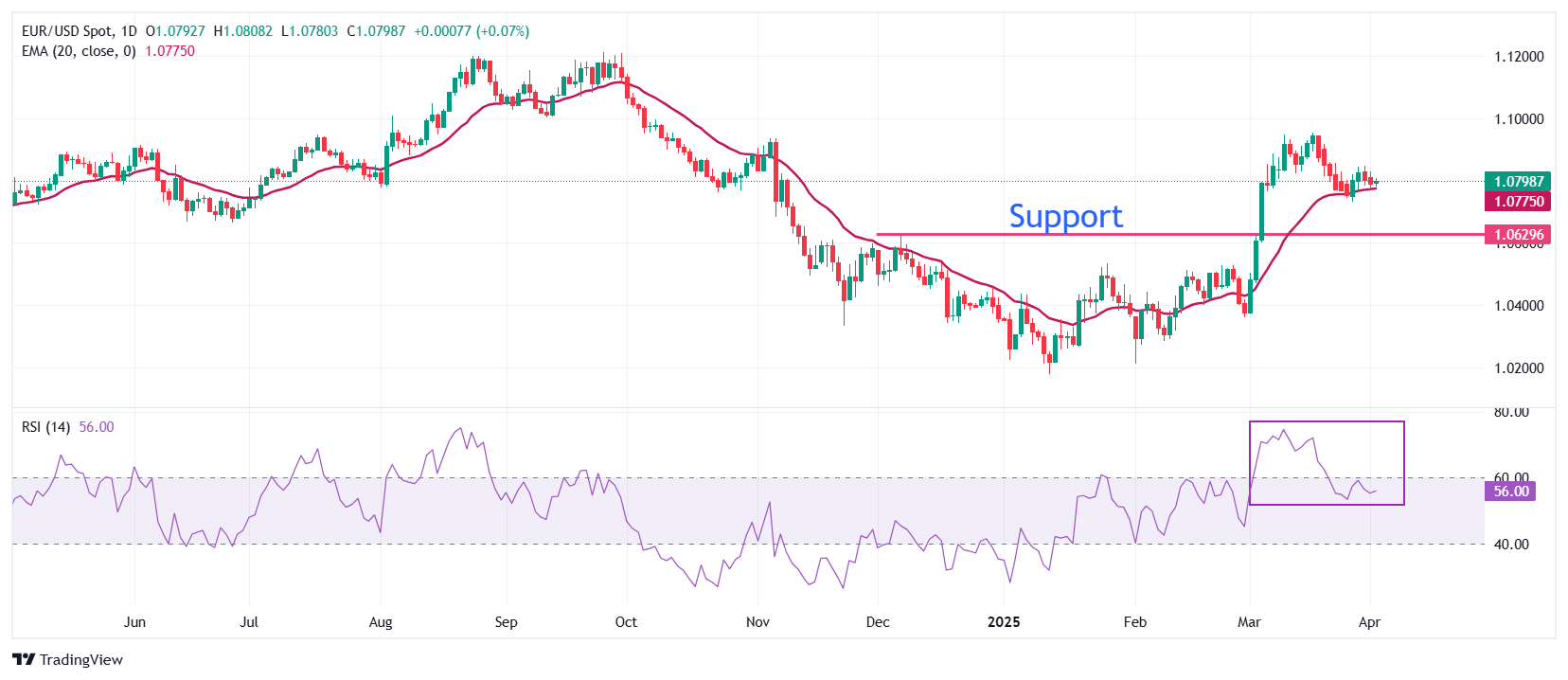- The EUR/USD moves up to 1,0820 before the announcement of reciprocal tariffs of US President Trump.
- Anxiety for Trump’s tariffs has decreased the confidence of US companies and households.
- The weak HICP data of the Eurozone raid the way for more ECB’s interest rate cuts.
EUR/USD rises to about 1,0820 during negotiation hours in North America on Wednesday. The main currency pair wins as the US dollar (USD) decreases before the announcement of reciprocal tariffs by the president of the United States (USA) Trump at 20:00 GMT. The US dollar index (DXY), which tracks the value of the dollar against six main currencies, falls to about 104.00.
Investors expect Trump tariffs to also be unfavorable for the US economy, considering the deterioration of consumers and companies. The purchasing managers index (PMI) ISM also showed on Tuesday that business activity contracted in March after expanding for two consecutive months. “Demand and production retreated, and the reduction of personnel continued, since the companies of the panelists responded to the confusion of the demand,” said Timothy Fiore, president of the Manufacturing ISM.
The new set of tariffs of President Trump is expected to enter into force immediately after the announcement. Such scenario will disrupt the global commercial system, making the products of the countries that will attract higher tariffs less competitive. The greatest import rights will also result in a slowdown in global business investment, since companies would have difficulty determining the demand for demand for their products.
The comments of the US Treasury Secretary, Scott Besent, on Tuesday also indicated that the president will impose the highest level of encumbrances to his commercial partners and said that the target countries could avoid them complying with the demands of the US, specifically decreasing import rates from the US.
Meanwhile, ADP employment change data for March have been better than expected. The private employers of the USA added 155K workers, significantly more than the 105K estimates and the previous 84K publication, upward from 77K.
American dollar today
The lower table shows the percentage of US dollar change (USD) compared to the main coins today. US dollar was the strongest currency against the Canadian dollar.
| USD | EUR | GBP | JPY | CAD | Aud | NZD | CHF | |
|---|---|---|---|---|---|---|---|---|
| USD | -0.58% | -0.35% | -0.01% | 0.01% | -0.46% | -0.77% | -0.18% | |
| EUR | 0.58% | 0.25% | 0.55% | 0.59% | 0.14% | -0.21% | 0.41% | |
| GBP | 0.35% | -0.25% | 0.35% | 0.36% | -0.11% | -0.43% | 0.16% | |
| JPY | 0.01% | -0.55% | -0.35% | -0.01% | -0.48% | -0.80% | -0.20% | |
| CAD | -0.01% | -0.59% | -0.36% | 0.01% | -0.47% | -0.77% | -0.19% | |
| Aud | 0.46% | -0.14% | 0.11% | 0.48% | 0.47% | -0.32% | 0.27% | |
| NZD | 0.77% | 0.21% | 0.43% | 0.80% | 0.77% | 0.32% | 0.60% | |
| CHF | 0.18% | -0.41% | -0.16% | 0.20% | 0.19% | -0.27% | -0.60% |
The heat map shows the percentage changes of the main currencies. The base currency is selected from the left column, while the contribution currency is selected in the upper row. For example, if you choose the US dollar of the left column and move along the horizontal line to the Japanese yen, the percentage change shown in the box will represent the USD (base)/JPY (quotation).
What moves the market today: the EUR/USD rises in the midst of the weakness of the US dollar
- The EUR/USD moves up despite the fact that investors expect the European Union (EU) to be one of the main US business partners that will attract the highest tariffs. The president of the USA, Donald Trump, has accused the EU on several occasions of unfair commercial practices with the USA Trump has blamed the Eurozone for not buying enough US assets.
- The wide Trump tariffs on the Eurozone will significantly impact the economic perspectives of the region. Last week, the president of the ECB, Christine Lagarde, said the commercial war could subtract 0.5% to the economic growth of the block. Less economic growth and the decrease in inflationary pressures in the Eurozone would increase the expectations that the European Central Bank (ECB) cut interest rates in the policy meeting this month.
- On Tuesday, Eurostat reported that the Harmonized Basic Consumer Price Index (HICP) – that excludes volatile elements such as food, energy, alcohol and tobacco – increased at a slower pace of 2.4% in 12 months until March, compared to estimates of 2.5% and the previous publication of 2.6%. During Wednesday’s European negotiation hours, Christine Lagarde was also confident in her interview at the Newstalk Irish radio station that the battle against inflation will end soon. “There is still some work to do in inflation, but it is very close to the goal,” said Lagarde.
- EUROZONA prospects could worsen if the European Commission takes retaliation measures against Trump tariffs. The president of the European Commission, Ursula von der Leyen, warned Tuesday, “we do not necessarily want reprisals, but if necessary, we have a solid plan to do so, and we will use it.”
Technical analysis: EUR/USD maintains the key level of 1,0800
The EUR/USD advances slightly but remains within Tuesday’s range, quoting around 1,0800 at the time of writing on Wednesday. The 20 -day exponential mobile average (EMA) continues to provide a support to the torque around 1,0778.
The 14 -day relative force index (RSI) cools below 60.00, suggesting that the bullish impulse is over, but the upward trend is maintained.
Looking down, the maximum of December 6, 1,0630 will act as the main support zone for the torque. On the contrary, the psychological level of 1.1000 will be the key barrier to the euros of the euro.
Economic indicator
Tariff ads of the “Liberation Day” of the United States.
The president of the USA, Donald Trump, will announce great scope tariffs at an event he called “Liberation Day.” The measures could significantly affect global trade and financial assets.
Read more.
Source: Fx Street
I am Joshua Winder, a senior-level journalist and editor at World Stock Market. I specialize in covering news related to the stock market and economic trends. With more than 8 years of experience in this field, I have become an expert in financial reporting.








